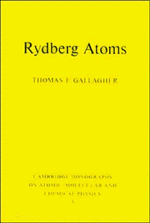Book contents
- Frontmatter
- Contents
- Preface
- 1 Introduction
- 2 Rydberg atom wavefunctions
- 3 Production of Rydberg atoms
- 4 Oscillator strengths and lifetimes
- 5 Black body radiation
- 6 Electric fields
- 7 Pulsed field ionization
- 8 Photoexcitation in electric fields
- 9 Magnetic fields
- 10 Microwave excitation and ionization
- 11 Collisions with neutral atoms and molecules
- 12 Spectral line shifts and broadenings
- 13 Charged particle collisions
- 14 Resonant Rydberg–Rydberg collisions
- 15 Radiative collisions
- 16 Spectroscopy of alkali Rydberg states
- 17 Rf spectroscopy of alkaline earth atoms
- 18 Bound He Rydberg states
- 19 Autoionizing Rydberg states
- 20 Quantum defect theory
- 21 Optical spectra of autoionizing Rydberg states
- 22 Interseries interaction in bound states
- 23 Double Rydberg states
- Index
11 - Collisions with neutral atoms and molecules
Published online by Cambridge University Press: 29 September 2009
- Frontmatter
- Contents
- Preface
- 1 Introduction
- 2 Rydberg atom wavefunctions
- 3 Production of Rydberg atoms
- 4 Oscillator strengths and lifetimes
- 5 Black body radiation
- 6 Electric fields
- 7 Pulsed field ionization
- 8 Photoexcitation in electric fields
- 9 Magnetic fields
- 10 Microwave excitation and ionization
- 11 Collisions with neutral atoms and molecules
- 12 Spectral line shifts and broadenings
- 13 Charged particle collisions
- 14 Resonant Rydberg–Rydberg collisions
- 15 Radiative collisions
- 16 Spectroscopy of alkali Rydberg states
- 17 Rf spectroscopy of alkaline earth atoms
- 18 Bound He Rydberg states
- 19 Autoionizing Rydberg states
- 20 Quantum defect theory
- 21 Optical spectra of autoionizing Rydberg states
- 22 Interseries interaction in bound states
- 23 Double Rydberg states
- Index
Summary
The large size and low binding energies, scaling as n4 and n−2, of Rydberg atoms make them nearly irresistible subjects for collision experiments. While one might expect collision cross sections to be enormous, by and large they are not. In fact, Rydberg atoms are quite transparent to most collision partners.
Collisions involving Rydberg atoms can be broken into two general categories, collisions in which the collision partner, or perturber, interacts with the Rydberg atom as a whole, and those in which the perturber interacts separately with the ionic core and the Rydberg electron. The difference between these two categories is in essence a question of the range of the interaction between the perturber and the Rydberg atom relative to the size of the Rydberg atom. A few examples serve to clarify this point. A Rydberg atom interacting with a charged particle is a charge–dipole interaction with a 1/R2 interaction potential, and the resonant dipole–dipole interaction between two Rydberg atoms has a 1/R3 interaction potential. Here R is the internuclear separation of the Rydberg atom and the perturber. In both of these interactions the perturber interacts with the Rydberg atom as a whole. On the other hand when a Rydberg atom interacts with a N2 molecule the longest range atom–molecule interaction is a dipole–induced dipole interaction with a potential varying as 1/R6.
- Type
- Chapter
- Information
- Rydberg Atoms , pp. 195 - 249Publisher: Cambridge University PressPrint publication year: 1994



